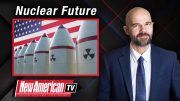
The New York Times and Politico reported on December 16 that the Defense Department launched a program in 2007 to study reports of UFOs, videos of encounters between military pilots and unknown objects, and interviews with people who said they had “experienced physical effects” from encounters with the unidentified flying objects. The initial funding for the program came mostly at the request of former U.S. Senator Harry M. Reid (D-Nev.), who was long known for his interest in space phenomena. The program ended in 2012.
According to the media reports, the Advanced Aviation Threat Identification Program (AATIP) was launched following a conversation that Reid had with his longtime friend, Robert Bigelow, the billionaire founder of Bigelow Aerospace, a space technology company and government contractor. Bigelow has spoken about his belief in UFOs visiting the United States as well as the existence of extraterrestrial aliens.
The program’s existence was not classified but operated with the knowledge of an extremely limited number of officials. Reid was supported in his efforts to fund the program by the late Senators Daniel Inouye (D-Hawaii) and Ted Stevens (R-Alaska), two World War II veterans who were both concerned about the potential national security implications of unidentified flying objects, the sources cited by Politico said.
While UFOs are generally associated with extraterrestrial origins, those behind the establishment of the program considered other possibilities. One possible theory behind the unexplained incidents, according to an unnamed former congressional staffer, was that a foreign power — perhaps the Chinese or the Russians — had developed advanced technologies that could threaten the United States.
“Was this China or Russia trying to do something or has some propulsion system we are not familiar with?” said the former staffer, who spoke with Politico on condition of anonymity.
The report in Politico cited a Pentagon official who said the AATIP program was ended “in the 2012 time frame.” However, the program has recently attracted attention because of the resignation in early October of Luis Elizondo, the career intelligence officer who ran it. In his resignation letter, addressed to Secretary of Defense James Mattis, Elizondo said the efforts of his program were not being taken sufficiently seriously. The Pentagon official could not confirm that Mattis had actually seen his letter.
“We tried to work within the system,” Elizondo told Politico in a recent interview. “We were trying to take the voodoo out of voodoo science.”
The Washington Post reported on December 16 that Elizondo was responsible for the public release of footage taken by U.S. fighter jets that appears to show aerial objects maneuvering in inexplicable ways in what has been called the USS Princeton aerial object incident. The Post also stated that it had conducted several interviews with Elizondo and former Deputy Assistant Secretary of Defense for Intelligence Christopher Mellon, who is associated with Elizondo in a private venture named To the Stars Academy for Arts and Sciences.
A December 17 Washington Post report carried by the Sacramento Bee provided more details of Elizondo’s role in securing the release of the video taken by cockpit cameras aboard a U.S. Navy F/A-18 Super Hornet. A retired Navy pilot contacted by the Post who was involved in a 2004 encounter depicted in one of the videos confirmed that the images accurately reflected his recollection of the events. However, the pilot would only speak on the condition of anonymity. According to the report, Elizondo, a 22-year veteran of the Defense Department who held top security clearance and worked on secret counterintelligence missions, said he chose to join the private venture because he believed it was the best way to continue the work he was unable to complete as a government employee.
“I left to find an environment where investigating these phenomena is priority number one,” he said.
As noted earlier, the AATIP came to an end five years ago.
“The Advanced Aviation Threat Identification Program ended in the 2012 timeframe,” Pentagon spokesman Tom Crosson told CNN. “It was determined that there were other, higher priority issues that merited funding and it was in the best interest of the DoD to make a change.”
However, according to the Times, certain aspects of the program still exist with officials from the program continuing to investigate encounters brought to them by service members, in addition to carrying out their other duties within the Defense Department.
“This was so-called black money,” Reid told the Times regarding the Defense Department budget for classified programs.
One obvious reason why Reid and the others found it necessary to conduct an end run around the usual budgetary path is that the Constitution requires that all bills for raising revenue must originate in the House. The supporters of appropriating funds to investigate UFOs (even under such language as “anomalous aerospace threats,” as the program calls them) may have feared that such a request would not have been taken seriously enough to secure passage in the House, or even in the full Senate. And while the cost of the program was not enormous by Defense Department standards ($22 million over the five years o the program’s existence), a strict constitutionalist would say that in such situations it is not the amount that matters so much as following constitutional requirements to the letter.
While investigating UFOs is hardly authorized by the Constitution, neither is our entire space program, and the space shuttle program alone cost $200 billion. The only legitimate constitutional case that could be made for spending federal dollars on space exploration is that space travel might be useful for our national defense, especially if our enemies travel to space. And, as we saw, the former congressional staffer noted that the possibility that some UFO sightings (particularly those tracked by Navy jets in the USS Princeton aerial object incident) may have been attributed to a foreign power having developed advanced technologies that could threaten the United States.
The obvious answer is that any funds spent on such projects should be appropriated by Congress, where their merits and constitutionally can be openly debated.
Graphic: MATJAZ SLANIC/E+/Getty Images



